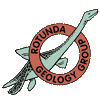The Robinson Ammonite Collection

Some specimens were collected from material on the beach, having been removed from their position in the bed rock by natural erosion. The geological horizon of these specimens was identified by their known range of strata listed in literature and from personal observation. Most specimens were collected in situ from bedrock in quarries, cliffs or wave-cut platforms. In all cases the geographical location of each ammonite is given with a six figure grid reference.
The collection consists of ammonites from the Redcar Mudstone Formation, Staithes Sandstone Formation, Cleveland Ironstone Formation and Whitby Mudstone Formation of the Yorkshire Coast, ranging from Runswick Bay to Blea Wyke at Ravenscar. Ammonites were also collected from the Osgodby Formation (Red Cliff Rock Member) of Cayton Bay and Kelloways Formation of Drewton Cutting at South Cave. The Hackness Rock Member of the Osgodby Formation at Cunstone Nab, Hackness Rock Pit and Cayton Bay also yielded a number of ammonites. Specimens were obtained from the Oxford Clay Formation of Gristhorpe Bay; the Lower Calcareous Grit Formation at Tennant’s Cliff, Cayton Bay, and a small number of inland localities near Scarborough. The Coralline Oolite Formation of the Ayton area and the Kimmeridge Clay Formation near Reighton Gap provided a small number of specimens.
Ammonites from the Speeton Clays were given into the hands of Prof. Peter Rawson for the purposes of his research. They are not included in the Robinson Collection.
The Robinson Collection of ammonites was given to the Geology Department of Hull University in the late 1960’s. Following the closure of the Geology Department at Hull University the Robinson Collection was handed over to Kingston-upon-Hull Museum, where the collection was reviewed in December 2008 and January 2009.
During the review in December 2008 some five specimens, with their details, were found to be missing. These were replaced on the 3rd. March 2009 with five specimens from Peter C. Robinson's private teaching collection and numbered with the numbers initially given to the five missing specimens.
Identification was obtained from Buckman’s Yorkshire Type Ammonites Vols. 1-7 (see below), appropriate Palaeontographical Monographs and Spath’s Liparoceratid Ammonites. Many of the Liassic ammonites were checked against specimens on display in the Whitby Museum. Most specimens were checked by the late Prof. John Neale, one or two by the late Prof. Hemingway of Leeds and some rare Liassic ones by the late Dr. Leslie Bairstow of the British Museum.
An A-Z listing of all the ammonites can be viewed here.
- Volume 1
- | Volume 2
- | Volume 3
- | Volume 4
- | Volume 5 [Unavailable]
- | Volume 6
- | Volume 7
- The scale shown on the photographs of ammonites in the collection is: one box = one centimeter. For example the photograph above has a scale showing three centimeters.
- The map only serves to illustrate the general location of the site and not the exact location of the fossil. The grid reference provided identifies an area 100m x 100m but the mapping software displays this as a point.
